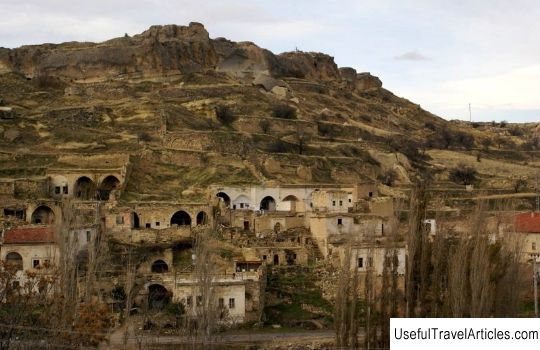Mustafapasа description and photos - Turkey: Cappadocia
Rating: 8,2/10 (4234 votes) 
Mustafapasa description and photos - Turkey: Cappadocia. Detailed information about the attraction. Description, photographs and a map showing the nearest significant objects. The name in English is Mustafapasа. Photo and descriptionThe village of Mustafapasha is located in a gorge at a distance of five kilometers from Yurgup. The Rumians called this village Sinoson or Sinosos, and the Turks changed the name to Mustafapasha. This place is attractive to tourists for its unique architecture of rural buildings. Cappadocia is Greek Turkey. From the very beginning of the Ottoman Empire, until the 20th century, a huge number of Greeks lived in Mustafapash, and only later the Turks settled here. Disagreements in religion and religion did not prevent the two peoples from having common relatives, business and everything that unites people in this life. It was one of the important Greek centers in Turkey. To this day, Greek mansions, churches, monasteries have been preserved here. There is a two-story monastery in the village, used today as a hotel for tourists. Inside, there are murals in fairly good condition. Also not far from the village is the Church of St. Basil. This area was sacred for both Christians and Muslims. They say that it was here that a miracle took place, performed by Haji Bektash, the founder of the dervish movement. Once Haji was walking from Kayseri to Yurgup and next to today's Mustafapashi he met a Christian woman. The girl was carrying a tray of cakes. In a conversation with Bektash, she complained about the poor quality of the bread and asked the dervish for help. Haji answered her: "From now on you will sow rye and gather wheat, and bake large cakes from flour." As he said, that's what happened. In honor of this event, residents of nearby settlements built a sanctuary on the site where Bektash met the girl. From this story, one can judge the friendly relations that existed between the Christians of Anatolia and the dervish sects. The Greek population begins to gradually grow, and the city is called Sinasos, i.e. "City of fishermen". By 1850, about 450 Turks and 4500 Greeks were already living there. The development and prosperity of the fishing business was facilitated by the river and lake Damsa, located nearby. The scope of this business can be judged by the fact that the Greek guild from the city of Sinasos held a monopoly on the salted fish and caviar business in Constantinople. During these years, the city reached its peak. Here in the 19th century, beautiful mansions, churches, baths, educational institutions and fountains, many of which have survived, began to be built. A school for girls is also being built here, and the library of the boys' school contains over a thousand books, and not only on religious topics. Sinasos becomes an educational and religious center for the Greek population living in the region of Cappadocia. But the fateful 1920s came. Unfortunately, they did not pass by Sinasos. According to the agreement, the entire Greek population of Turkey was expelled to Greece, the Turkish population of Greece from their homes to Turkey. Officially, this act was called “population exchange”. Some of the deported Greek Turks settled here. But the Turks, judging by the current state of the city, clearly could not adapt to the new place. Sinasos is renamed Mustafapash in honor of Ataturk. Soon, the fishing business rotted on the vine, and the city gradually fell into decay, turning almost into a village, which can be seen today. Most of the Greek mansions are works of art, empty and abandoned. Many houses are destroyed, windows are smashed. The average Greek mansion in Sinasos usually looked like this. There is a courtyard, in which a place for winemaking was necessarily provided. Houses often had two floors. Some parts of the houses were often carved directly into the rock (this feature is typical for most houses in Cappadocia). In the rocky part and on the ground floor there was a kitchen, premises for various household needs, a toilet and storage facilities. The living area was located on the second floor. In the underground part of the houses, which cannot be called a basement, there are rooms with vaulted ceilings. This room was used as a family church. Each house was distinguished by its unique stone carvings. There is also the temple of Saints Helena and Constantine. It is carved into the rock and rests on four columns. It is accessed by steps carved from stone. In the gorge, just below, you can see the Church of the Holy Cross, built of stone blocks in the rock. Inside it, the frescoes depict the second coming of Christ. While in Mustafapasha, you should definitely visit the valleys around the city. You can also see the monastery of Keshlik, Sobessos, Tashkinpasha, and if you have a car - Kaymakli, the village and underground city of Mazy, the Damsa reservoir and the Soganly valley. And, of course, you have to wander the streets of the city. Here you can see many old Greek houses of the 19th century, in which local residents live, some have been converted into hotels, some are in desolation. Most of them are built from a special stone brought from the Black Sea region. It is yellowish-white in color. There are hotels and guesthouses in Mustafapasha, many of them are located in old Greek mansions. We also recommend reading Svir gorge description and photos - Russia - South: Lazarevskoye Topic: Mustafapasа description and photos - Turkey: Cappadocia. |




